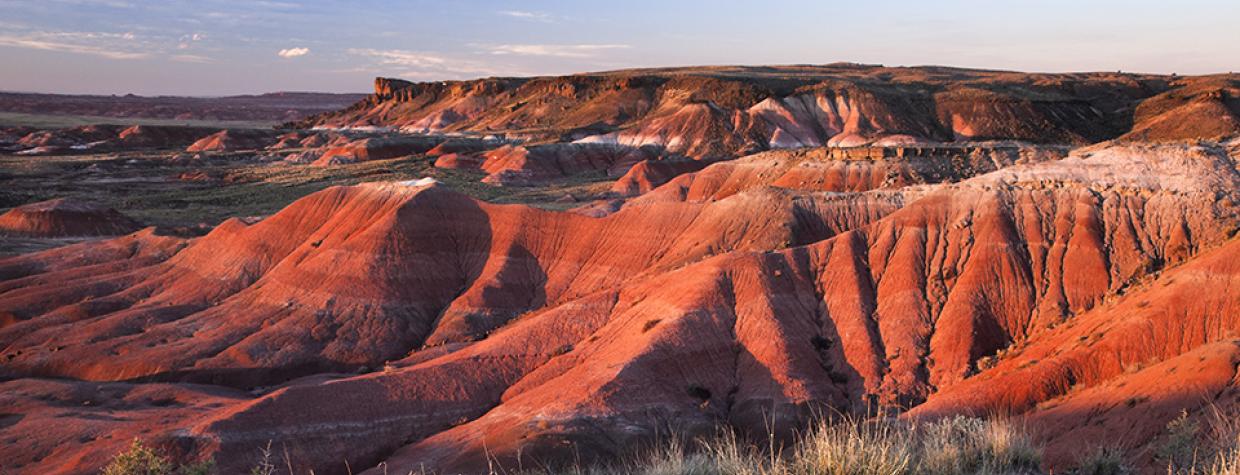Near Holbrook
“On March 1, the monument was visited by one of the most distinguished persons who ever came to view its wonders.” The year was 1931, the monument was Petrified Forest, and the person was Albert Einstein. He and his wife, Elsa, had come to see the 200 million-year-old petrified trees that put the place on the map. The quote comes from a report by the monument superintendent, who continues: “Dr. Einstein fired a multitude of questions at us, evidencing the greatest interest in the ‘whys’ and ‘hows.’ ”
“Why?” and “How?” remain pressing questions for visitors to what now is Petrified Forest National Park. And while a 29-mile drive through the park won’t completely answer them, it will provide a glimpse of the park’s natural and human history — with incredible views along the way.
Reset your odometer when you turn onto the park road from U.S. Route 180. Just past the entrance station is the Rainbow Forest Museum, which has several exhibits on the park’s prehistory and how its petrified wood was formed. After these trees died and fell into a river, they were covered by silt, mud and volcanic ash. They then absorbed mineral-laden groundwater, and the minerals bonded with the cells of the trees, eventually replacing the organic material. You can see the results up close on the Giant Logs Trail, an easy interpretive loop that starts at the museum. Grab a trail guide to help you find “Old Faithful,” a 35-foot petrified log where the Einsteins posed for a photo in 1931.
Back on the road, you’ll begin winding through the alien landscape of the park’s badlands. The rounded buttes here are an arresting sight — like scoops of ice cream melting in the high-desert sun. At Mile 8 is the Crystal Forest Trail, a short, paved loop past colorful petrified logs. Two miles farther is an overlook of the Jasper Forest, which features a high concentration of petrified wood. And just past that overlook is Agate Bridge, where water has carved a gully under a fallen petrified tree.
The 3.5-mile loop drive to Blue Mesa is next up, and its colorful badlands and rock logs are a nice side trip if you’ve got the time. If not, continue past the Tepees, a series of conical buttes, to Newspaper Rock, at Mile 16.5. Here, an overlook offers a view of hundreds of petroglyphs, some of which are more than 2,000 years old. It’s one of more than a thousand archaeological sites in the park. More of Petrified Forest’s human history can be found just to the north, at Puerco Pueblo. There, you can see petroglyphs and Ancestral Puebloan dwellings along a short loop trail.
North of Interstate 40 is Historic Route 66 — or what’s left of it. Petrified Forest is the only national park that contains a segment of the Mother Road; today, weathered telephone poles mark the road’s path. Several more viewpoints follow as the road curves east, then south. They’re all worth a visit, but don’t miss the panorama at Pintado Point (Mile 26.2), where you can see Lithodendron Wash, nearby buttes and the distant San Francisco Peaks.
After Pintado Point, you’ll pass the historic Painted Desert Inn before arriving at the Painted Desert Visitor Center, the stopping point for this drive. From here, it’s just a bit farther to I-40, but the visitors center is worth a stop, since you’ll probably have questions about how this otherworldly place came to be. Petrified Forest National Park has that effect on people. Even Albert Einstein.
Note: Mileages are approximate.
Length: 29 miles one way (from U.S. Route 180)
Directions: From Holbrook, go southeast on U.S. Route 180 for 17.5 miles to the Petrified Forest National Park entrance road. Turn left onto the entrance road and continue 29 miles to the Painted Desert Visitor Center.
Vehicle requirements: None
Special consideration: National Park Service entrance fees apply.
Information: Petrified Forest National Park, 928-524-6228 or www.nps.gov/pefo

